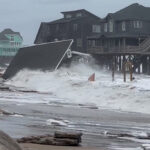Monsoons are about the only thing right now that could bring much needed relief to wildfire-plagued Western states like Colorado and New Mexico, which are both on track to have fire seasons on a historic level – although the annual weather phenomenon could actually make things worse.
That’s according to the National Weather Service, which has yet to forecast just when the monsoon season will arrive in the region or how wet things will get.
“It could be a long (fire) season in Colorado, but it could be shortened if the monsoon kicks in,” said Heath Hockenberry, national fire weather program manager for NWS.
The monsoon season normally arrives around the first week of July and moves into portions of New Mexico and Colorado sometime around the second week of the month, bringing generous amount of rain – sometimes as much an one or two inches of rain within a half-hour period. Continuing periods of intense, short-duration rain can be experienced over several weeks.
Any rain would be welcome relief to a region where humidity’s been in the single digits for some time, said Carole Walker, executive director of the Rocky Mountain Insurance Information Association.
“I think that we’re hopeful that even though that we’re at the start of our wildfire season and we’ve had this string of hot, dry temperatures, at the same time we are entering our monsoonal season,” Walker said. “The hope is that we get into a cycle of increased moisture, but you just don’t know.”
Walker’s “you just don’t know” assessment isn’t just pessimism. According to NWS, it’s difficult to know very far out if there’s a strong monsoon season brewing.
“They’re very hard to detect more than a couple of weeks out,” Hockenberry said. “An on time arrival is the best shot right now.”
Monsoons brew when weather patterns shift around and high pressure systems develop based on increased heating. A subtropical high gets parked off the south coast of Florida and that flow starts picking up thunderstorms in Central and Northern Mexico and transports them into the Southwest and the Rocky Mountains.
That combination, along with the water temperatures and the moisture content in the atmosphere, can yield a powerfully wet punch to wipe out any forest fires – or it could yield massive amounts of fire-starting lighting storms, Hockenberry said.
Pretty soon those monsoons will likely move in and sit over New Mexico’s Rockies for a period, and within three or four days after that they could move into the fire-stricken areas, and “it’s like the doors open up,” Hockenberry added. “Depending on where that sets up, usually you’ll get a monsoon starting in New Mexico.”
But even if the monsoon season only delivers a slight handout of moisture, there’s a chance for a least higher relative humidity, possibly in the 20 to 30 percent range, which could give some help to firefighting efforts.
“It looks like there’s a shot that at least the relative humidities will start coming up in the next two weeks or so,” Hockenberry said.
That would be a drastic improvement over the 3-8 percent humidity being seen in the fire-plagued areas in New Mexico and Colorado, humidity ranges that Hockenberry referred to as “extreme.”
On the flip side, monsoons sometimes don’t so much bring rain, but instead they yield a higher chance of lightning strikes. Lighting is what caused both Colorado’s and New Mexico’s biggest fires.
“So there’s the potential of new starts all the way through July,” Hockenberry warned.
That could make bad things worse in New Mexico, Colorado and other nearby states.
Colorado’s High Park Fire has burned more than 87,000 acres, making it the second largest in state history, but it’s most destructive. It’s estimated than nearly 257 residences have been lost, and Gov. John Hickenlooper has authorized roughly $25 million in emergency funds for the fire. The cost of the fire to date is estimated to be $31.5 million.
Several large fires have burned in drought-stricken New Mexico. The Little Bear Fire was 90 percent contained as of Tuesday, but had burned more than 44,000 acres and destroyed 254 structures. The largest wildfire in New Mexico’s history, the Whitewater-Baldy Complex Fire in Gila National Forest, continued to burn at roughly 300,000 acres, although it is now 87 percent contained.
Factors contributing to such a rough fire season are a combination of dry conditions, extremely hot temperatures and the long period between large fire seasons that allowed large amounts of unburned fuel to grow, Hockenberry said.
When the Rocky Mountain area experienced its last benchmark fire season it was 2002, which was marked by Colorado’s Hayman Fire, which burned 138,114 acres and destroyed 133 homes.
Since then the amount of fire fuel has continued to grow, posing an ever greater risk.
“That continues to be a concern,” RMIIA’s Walker said.
Walker has been on scene regularly at Colorado’s High Park Fire, which is now 55 percent contained.
She said insurers are still trying to get a handle on insured losses, which has been hard as many areas have required evacuations and insurance professionals have not be able to get in and assess damages in many cases.
“It’s been a moving target,” she said. “We are still trying to get information from companies on structures that have been lost that were insured. We’re going to see everything from smoke damage to living expenses, to property damage to vehicle damage to lost structures.”
Was this article valuable?
Here are more articles you may enjoy.


 More NC Outer Banks Homes Collapse into Surf as Hurricanes Stay Far Offshore
More NC Outer Banks Homes Collapse into Surf as Hurricanes Stay Far Offshore  Allstate Promotes Rizzo to COO, Merten to President of Property-Liability
Allstate Promotes Rizzo to COO, Merten to President of Property-Liability  IBHS Study Shows Smaller Hail May Be More Damaging to Roofs Than Once Believed
IBHS Study Shows Smaller Hail May Be More Damaging to Roofs Than Once Believed  The LA Fires Destroyed 11,000 Homes. Less Than 10% Have Permits to Rebuild
The LA Fires Destroyed 11,000 Homes. Less Than 10% Have Permits to Rebuild 

